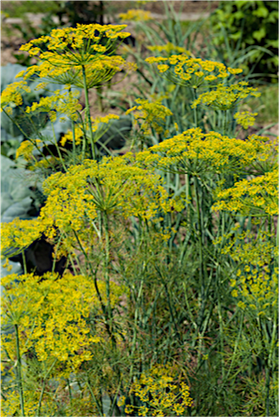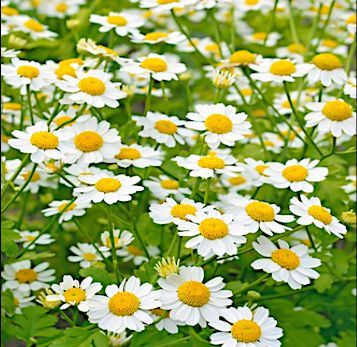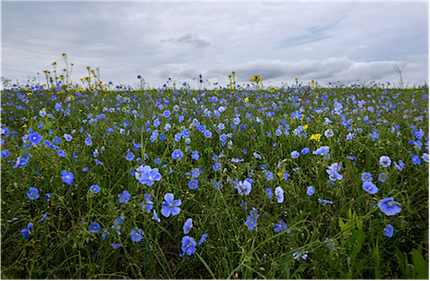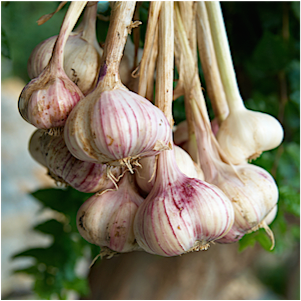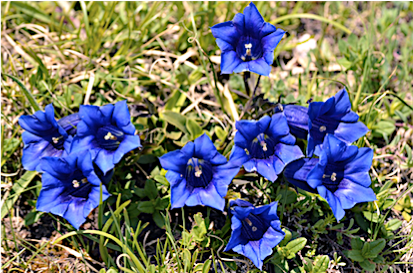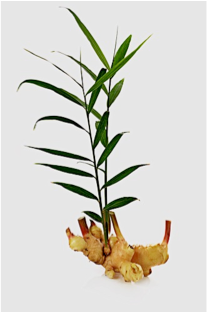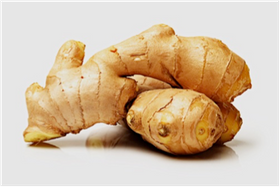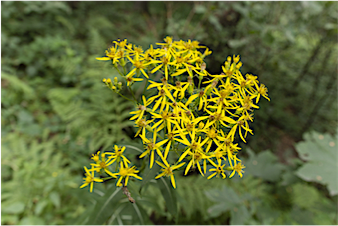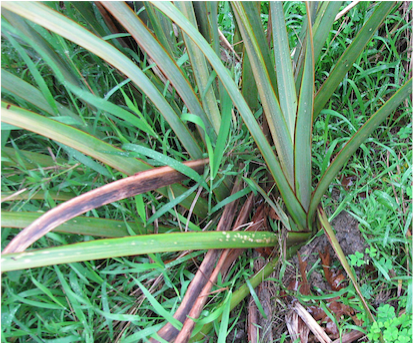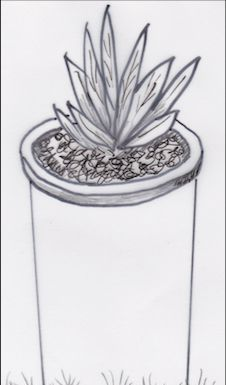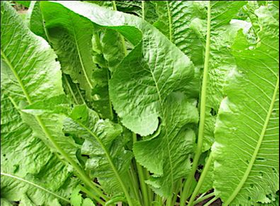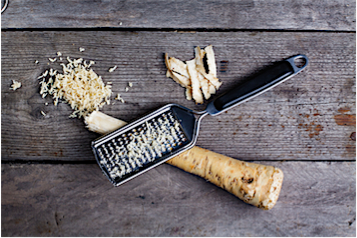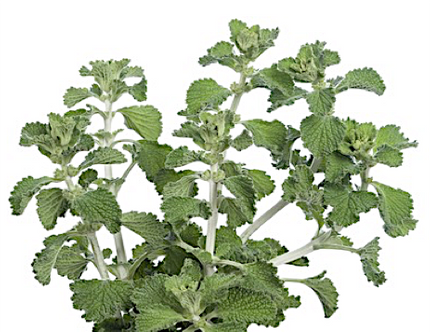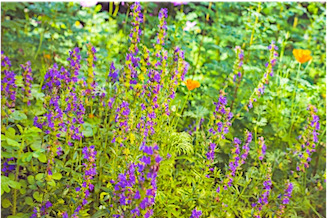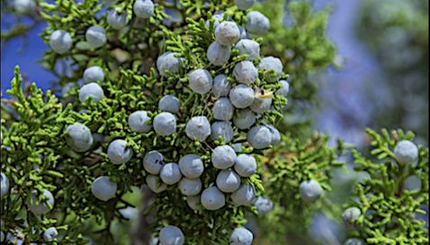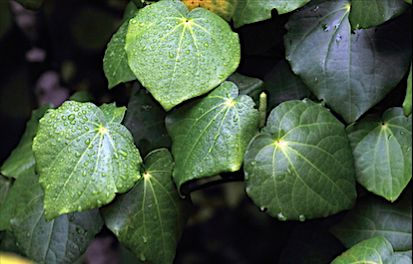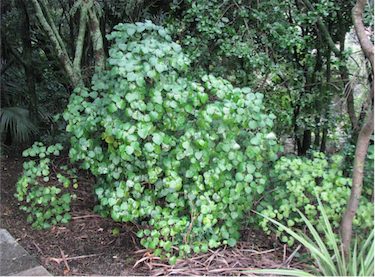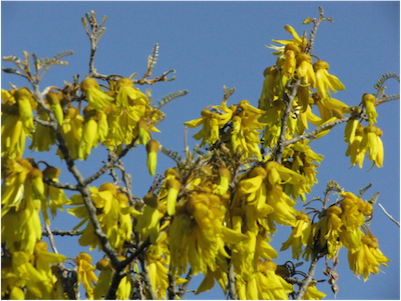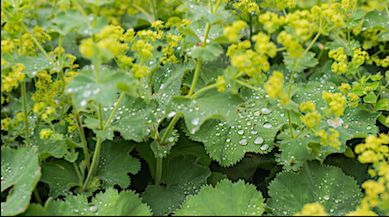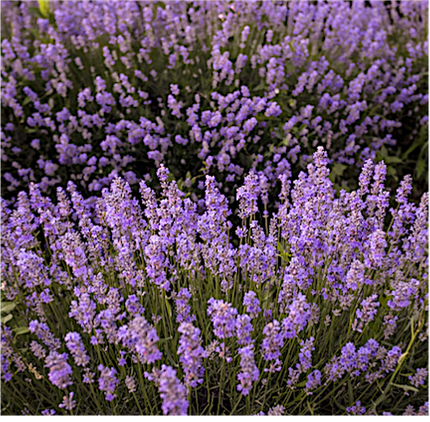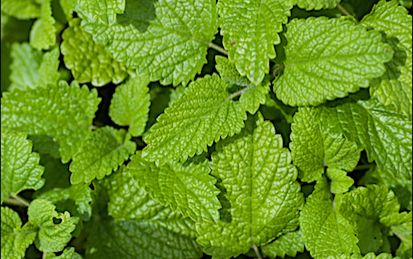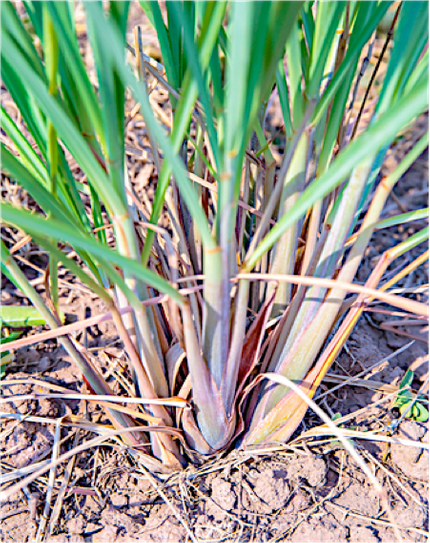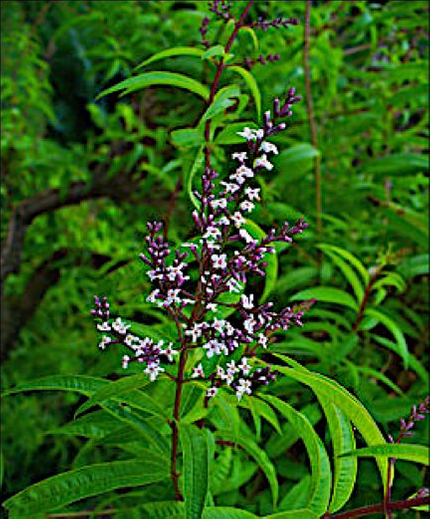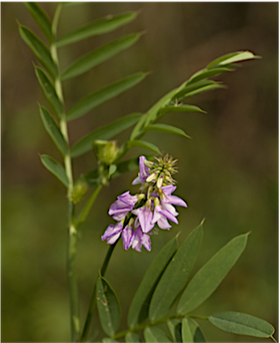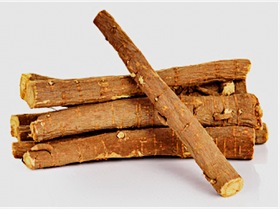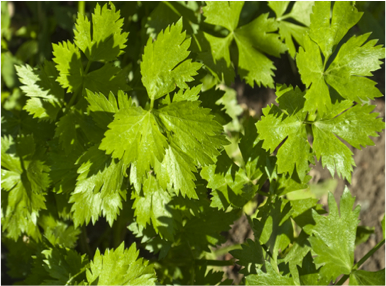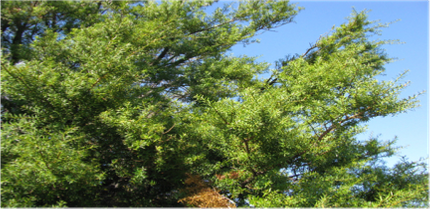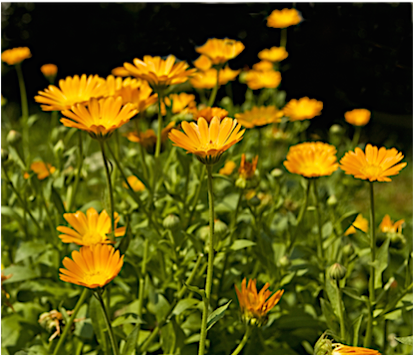The Miracle of Growing Food Regeneratively
Creating Local Food Security & Healthy, Vibrant, Regenerated Living Soil, & Nutrient Dense Food
GROWING HERBS F-M
CONTENTS:
1. FENNEL
2. FEVERFEW
3. FLAXSEED (Linseed)
4. GARLIC
5. GENTIAN
6. GINGER
7. GOLDEN ROD
8. HARAKEKE (New Zealand flax)
9. HORESRADISH
10. HOREHOUND
11. HYSSOP
12. JUNIPER BERRIES
13. KAWAKAWA
14. KÕWHAI
15. LADY’S MANTLE
16. LAVENDER
17. LEMON BALM
18. LEMONGRASS
19. LEMON VERBENA
20. LIQUORICE
21. LOVAGE
22. MÃNUKA
23. MARIGOLD
FENNEL (Foeniculum vulgare)
Fennel definitely has its uses, both in cooking and medicine. It grows 1-1½m (3-5ft) high. It has a stronger taste than dill.
Soil & Sight:
As it grows anywhere and everywhere, just grow it in a corner where it can be controlled and kept in its place. Take the seed heads off before the seeds drop, to stop it seeding.
Sowing:
Sow in seed compost in the spring and plant out into its permanent place when the seedlings are 5-6cm (2-2½in) high.
Harvesting: The leaves can be dried, and the seed heads cut off before the seeds drop to finish drying in a glasshouse or other dry sunny spot, then rub off seeds and store in dry sealed jars.
Companions:
Fennel doesn’t have any friends; so provide a wild corner on its own.
Beneficial Insect Attractant:
Beneficial insects love the flower heads.
Culinary Uses:
The leaves are used with oily fish. Added to white sauces, etc.
Medical Uses:
Fennel seed is one of the best herbs for digestion.
Actions: Carminative, stomachic, diuretic, antispasmodic
Part Used: Seeds.
FEVERFEW (Chrysanthemum parthenium)
Feverfew is a perennial, and herbaceous in habit, with white daisy flowers.
Soil & Sight:
Any ordinary good soil is suitable, but better results are obtained with a well-drained loamy soil that has been enriched with garden compost – one bucket per square metre (yard).
Sowing:
Sow in seed compost in the spring and plant out 30cm (1ft) apart, when 4-5cm (1½-2in) high. Propagation can also be done by division and cuttings.
Growing:
Weeding should be done by hand, especially when the plants are young.
Harvesting:
Both the leaves and the flowers can be dried on drying frames and stored in sealed jars.
Companions:
Feverfew is a good companion plant enhancing the growth of plants around it. Feverfew contains pyrethrin, a natural insect repellent. A weak infusion controls whitefly and spider mites. Dried and crushed flowers repel aphids and leafhoppers. Do not place near plants that need pollination, as bees rarely come near feverfew.
Beneficial Insect Attractant:
Feverfew flowers are said to attract the beneficial insect hoverflies.
Medical Uses:
As its name implies, Feverfew helps to reduce fever, but Feverfew is best well known for helping to avoid migraines, as a prevention, rather than counteracting a full blown migraine. It works by inhibiting the release of two inflammatory substances, serotonin and prostaglandins both believed to contribute to the onset of migraines. By inhibiting these amines as well as the production of the chemical histamine, the herb controls inflammation that constricts the blood vessels in the head and prevents blood vessel spasms, which may contribute to headaches. The cold infusion is made from 30g of the leaves to half a litre of boiling water, allowed to cool. Take half a teacupful morning and evening with a spoonful of honey to counteract the bitterness.
It also helps with menstrual cramps. Its ability to inhibiting the release of inflammatory substances might be the reason some people with arthritis get some relief from its use.
Actions: Aperient, carminative, bitter, emmenagogue
Part Used: Leaves & flowers.
FLAXSEED Linseed (Linum usitatissimum)
We once grew a patch of flaxseed on our farm for the production of seed, and the plants were beautiful when in flower; the patch was an electric sky-blue for several weeks.
Soil & Sight:
Flaxseed naturally grows of limestone or chalk hills, pH 6.5 would be the ideal, with the addition of two handfuls of gypsum per square metre, which will supply Lime (and Sulphur) without increasing the pH. Flaxseed also likes a well-drained soil with reasonable organic matter, so add some garden compost before sowing.
Sowing:
Sow one tablespoon of flax seeds per square metre (yard).
Growing:
Spray with liquid seaweed, about two weeks before flowering.
Harvesting:
When the seed heads are brown and drying, cut the plants and hang up in bunches to finish drying in a glasshouse, conservatory, or other warm dry place. Then rub the seed heads to extract the seeds, blow off the husks and store the seeds in dry sealed jars.
Companions:
Plant with carrots, and potatoes. Beneficial Insect Attractant: Bees love the flowers.
Culinary Uses:
To make flaxseed more digestible, grind the seeds in a coffee grinder and use fresh, or place in a Ziplock bag a store in the freezer.
Start your morning with a healthy dose of omega-threes by sprinkling over cold cereal or stirring it into hot cereal like oatmeal. Flax seeds add a slightly, but not overwhelming, nutty flavour. Add 1 tablespoon of whole, or ground, flax seeds into your morning smoothie for an extra 2g of protein. Add a 1/3 cup of ground seed to any bread mix.
Medical Uses:
Useful in relieving disorders of the chest or respiratory tract. Strengthens the lung tissue, promoting the healing of the lungs. A great food cooked for those that are convalescing. I used to cook up the seeds to give to our cows when they had just given birth.
Actions: Emollient, expectorant, demulcent, laxative
Part Used: Seeds.
GARLIC (Allium sativum)
You can find out about how to grow garlic in the section ‘How to Grow Vegetables’ – Soil & Sight, Varieties, Planting, Growing, Harvesting, etc.).
However, garlic is also classified as an herb, hence its place here.
Companions:
Plant near apple trees, pear trees, cucumbers, peas, lettuce and celery. Garlic accumulates sulphur, a naturally occurring fungicide, which will help in the garden with disease prevention. Garlic is systemic in action, as it is taken up by the plants through their pores, and when garlic tea is used as a soil drench it is also taken up by the plant’s roots.
Beneficial Insect Attractant:
Has value in offending codling moths, root maggots, snails, and carrot root fly.
Culinary Uses:
Oh so many, needless to say.
Medical Uses:
Garlic is a powerful rejuvenative herb. It is also a powerful detoxifier and is useful for chronic or periodic fevers.
A precautionary note: It is best not to use garlic on a regular basis, because it can dull the mind. Its heating properties can aggravate the blood and aggravate bleeding. So best use as and when it is required.
As a disinfectant it is very useful for small cuts and grazes. The reason for its effect is the volatile oil, which contains sulphur and traces of iodine. Cut a clove in two and rub the injury with the juice at the cut end. It is also good to apply the juice from a cut comfrey stem as well, so the garlic disinfects and the comfrey speeds up the healing.
Actions: Stimulant, carminative, expectorant, alterative, antispasmodic, disinfectant, anthelmintic, rejuvenative
Part Used: Bulb
GENTIAN (Gentiana acaulis + spp)
Native to the European Alps, this spring-flowering Gentian is a much-loved alpine plant that is not always the easiest to grow.
Soil & Sight:
As alpine plants, they prefer a well-drained acidic gritty soil that is also a water retentive humus-rich soil in partial shade.
Suitable for a rock garden or peat terrace Added grit or sharp sand and leaf mould or peat will help.
Sowing:
Sow on the surface of seed compost in a pot and sprinkle about 4mm (⅙in) fine grit over the seeds. Keep moist until the seedlings are up. Plant out when they are 4-5cm (1½-2in) high.
Growing:
Keep weeded.
Harvesting:
Harvest the roots in early winter and wash them thoroughly, then cut into smaller pieces and dry until hard. Store in sealed jars. Alternately, store the cleaned roots in a Ziplock bag in the freezer.
Beneficial Insect Attractant:
Attracts bees.
Medical Uses:
It has a long history of use as bitters, used to promote the appetite and digestion by general stimulation of the digestive juices, and therefore a remedy for physical and mental exhaustion. It is a traditional herbal remedy for symptoms of sluggish digestion, such as dyspepsia and flatulence. The herb is used as a liver tonic and to stimulate insufficient production of gastric juices, bile and saliva. It is used to alleviate inflammations in the gall bladder. It has anti-inflammatory and wound-healing effects. The herb is used internally as a remedy for sore throat and arthritic inflammation.
Cautionary Note: Gentian should not be used while pregnant, as it may not be well tolerated and has been documented to cause adverse effects. Gentian is contraindicated for individuals with excessive gastric acid secretions, those suffering from heartburn, gastric ulcers, duodenal ulcers, or high blood pressure.
Actions: bitter tonic, antipyretic, alterative, antibacterial, anthelmintic, laxative
Part Used: Root.
Decoction:
• 30g (1oz) dried root
• 30g (1oz) fresh lemon peel
• 6g (¼oz) dried orange peel
Simmer this mixture for one or two hours in 1/3 litre of boiling water.
Ginger plant
GINGER (Zingiber officinale)
Ginger is thought to have originated on the Indian sub-continent.
Soil & Sight:
Ginger is a tropical plant, so in sub tropical and Mediterranean climates they will grow outside. In the top of the North Island, New Zealand, growing ginger outside is possible. For those living in colder climates you will have to grow it in a glasshouse or Polytunnel. Ginger loves a sheltered spot, filtered sunlight, warm weather, humidity, and rich, moist soil. What ginger can't stand is frost, direct sun, strong winds, and soggy, waterlogged soil.
Ginger rhizome
Ginger requires good feeding, by adding to a square metre (yard) – two buckets of garden compost, and two handfuls of Eco or Organic Fertiliser.
Planting:
Plant offsets of the rhizome (preferably organic) with a growing point, planted on its side just under the surface of the soil, 15-20cm (6-8in) apart.
Growing:
Keep warm and watered. Ginger loves humidity, so if you have problems with dry air then regular spraying and misting might help.
Harvesting:
You can dig up the whole plant at the end of the second season and pick off the largest rhizomes, replanting some for the future. Alternately, fossick around the roots area, pulling off just what you need at the time.
Companions:
Friends with Basil & Tomatoes. Avoid Onions and Turnips
Culinary Uses:
So many! Use in curries, and other far eastern recipes.
Thinly julienned strips of fresh ginger cooked with julienned carrot in a little water and oil and seasoning is a great way of cooking carrots. Boil down the water, until almost evaporated, and the ginger and carrots are tender.
Use julienned strips in Chinese stir-fries.
Medical Uses:
Taking ginger tea, or chewing some ginger root will counteract nausea, especially those with travel sickness.
If one has symptoms of a cold or flue coming on, then chewing a slice of ginger root, sprinkled with a little salt, as well as taking echinacea, often stops the onset of illness.
Ginger tea also helps to promote healthy sweating, helpful during colds and flu.
Ginger contains very potent anti-inflammatory compounds called ‘gingerols’. These substances are believed to explain why so many people with osteoarthritis or rheumatoid arthritis experience reductions in their pain levels and improvements in their mobility when they consume ginger regularly. Ginger can also help with inflamed bowels. The root can also be smashed to a paste and applied to inflamed joints or muscles, or alternately oil of ginger can be rubbed into the affected area.
Actions: Anti-inflammatory, analgesic, antiemetic, carminative, expectorant
Part Used: Rhizome.
GOLDEN ROD (Solidago virgaurea)
Solidago means – ‘that which makes whole’. It is a perennial plant, growing ½-1m (1½-3ft) tall in flower.
Soil & Sight:
Goldenrod grows on banks and heathland, poor, rocky, and sandy soils, so give it a well-drained, soil with added leaf mould, in full sun or part shade. It doesn’t like rich soils - so no fertiliser.
Sowing:
Sow indoors in seed compost in early spring and plant out seedlings 30cm (1ft) apart.
Growing:
Weed and mulch with leaf mould. Harvesting: Dry the leaves on frames and store in sealed jars.
Companions: Grow at the back of a herb bed with other tall herbs, or at the edge of a forest garden.
Beneficial Insect Attractant:
The flowers attract beneficial insects.
Medical Uses:
Goldenrod has also been used to treat tuberculosis, diabetes, as a kidney tonic to counter inflammation and irritation caused by bacterial infections, for the enlargement of the liver, gout, haemorrhoids, internal bleeding, asthma, and arthritis and to aid in cleansing of the kidney or bladder. Traditionally it was used as a mouth rinse to treat inflammation of the mouth and throat.
The powdered leaves were used for the healing of old ulcers. It has been recommended in many maladies, including both dysmenorrhoea (painful menstruation) and amenorrhoea (absence of menstruation).
Actions: aromatic, stimulant, carminative, astringent, diuretic
Part Used: Leaves.
HARAKEKE New Zealand flax (Phormium tenax)
Harakeke is an evergreen perennial plant.
Soil & Sight:
Although harakeke is found in many places and is commonly seen growing in swampy ground, the best-quality plants grow on fertile, well-drained soil. Harakeke doesn't like stagnant water around its roots, although it doesn’t mind occasional flooding. Harakeke is very happy growing on the edge of running streams.
Sowing:
You can sow the seeds, but you can also transplant them, if you know someone with a plant. You can also dig out a growing point with its leaves from the cluster that makes up a fully-grown plant, along with its roots – see photograph:
Growing:
Weed and mulch with 5cm (2in) of wood chips or 15cm (6in) spray-free straw.
Harvesting:
As the plant is evergreen, there should be no reason to dry or preserve ant part of the plant – fresh is best.
Companions:
Great companion with other perennial shrubs and plants, like nut and fruit trees and taller herbs like Marsh Mallow.
Bird Attractant:
Tui and other native birds are attracted to the nectar in the flowers in this country, and bees as well.
Medical Uses:
Flax leaves or roots were made into pulp, heated and put on skin infections such as boils. Used to treat boils, tumours and abscesses, as well as to varicose ulcers. The pulp was also used to heal burns. Juice from pounded roots was used as an antiseptic and a mild anaesthetic, for cuts, aching teeth, to rheumatic and associated pains. It was also used internally to relieve constipation or expel worms. Chemical analysis shows that there are antifungal, anti-inflammatory drug musizin, and laxative anthraquinones in flaxes.
Actions: antifungal, anti-inflammatory, antiseptic, laxative, anaesthetic
Part Used: Leaves, roots, gum
HORESRADISH (Armoracia rusticana)
Horseradish is native to southeastern Europe and western Asia, but is now grown around the world. It is a perennial plant that dies down in the winter, regrowing its leaves in spring.
Soil & Sight:
Make sure you plant in an odd, out of the way corner, or forest garden. Horseradish is an aggressive grower and will quickly take over any garden. So my serious suggestion is to grow it in a 40-45cm (16-18in) diameter concrete, clay or plastic drain, standing upright with the bottom buried, like in the illustration, where it will be contained.
Horseradish leaves
Sowing:
As horseradish is grown from root cuttings, if you know someone who has it in their garden, just one piece of root will grow if you plant it.
Growing:
Mulch down with 10-15cm (4-6in) of spray-free straw, even if you grow it in a pot.
Harvesting:
In late autumn, when the leaves have died down, dig up the plant and cut off the roots you need, replanting in the same place. Alternatively, fossick around and cut off a bit of root. Clean thoroughly, and if using fresh, peal and grate the roots. For drying clean and cut up into small pieces and dry them and store, when hard, in sealed jars.
Culinary Uses:
Horseradish Sauce has been a favourite for generations as a condiment with beef, but it can be used with many other dishes, especially if you like hot condiments:
Ingredients:
• 15g (½oz) freshly grated horseradish
• 1 tablespoon white wine vinegar
• A pinch of English mustard powder
• A pinch of caster sugar
• Salt and pepper to taste
• 150ml (5floz) double cream, lightly whipped
Method:
1. Dig up a 20-25cm (8-10in) long root of horseradish.
2. Remove the leaves from the root and rinse the dirt off of the root.
3. Peel the surface skin off the root.
4. Grate 15g (½oz) of the root.
5. Mix with all the other ingredients.
6. Store in a jar in the fridge.
Medical Uses:
Horseradish is used for urinary tract infections, kidney stones, fluid retention, cough, bronchitis, achy joints (rheumatism), gallbladder disorders, sciatic nerve pain, gout, colic, and intestinal worms in children. When taken with food it is an excellent stimulant to the digestive organs, improving the complete digestion of protein rich foods in particular. It also has strong anti-inflammatory properties, and is used by placing a compress of the grated root on the painful spot.
Actions: Stimulant, aperient, anti-inflammatory, rubefacient, diuretic, antiseptic, antiviral, expectorant
Part Used: Root.
HOREHOUND White (Marrubium vulgare)
White horehound is a bitter herb from the mint family.
Soil & Sight:
Horehound is a hardy plant, easily grown, and grows best in a dry, poor soil, so a neglected corner in full sun would be an ideal spot.
Sowing:
Sow seeds in spring, planting out 22cm (8½in) apart.
Growing:
No further culture will be needed other than weeding.
Harvesting:
Dry leaves carefully in the dark in an airy place on a frame at around 20-300C (68-860F). Drying too hot or too cold will cause the leaves to turn black.
Companions:
Stimulates and aids fruiting in tomatoes and peppers.
Beneficial Insect Attractant:
Like many varieties in the mint family, the many tiny flowers attract beneficial insects such as Braconid and Icheumonid wasps, and Tachnid and Syrid flies. The larval forms of these insects parasitize or eat many other insect pests. For best results use horehound directly as a companion plant.
Medical Uses:
A study in 2011 found that M. vulgare contains an essential oil that had potent antimicrobial and anticancer properties, and another study in 2012 showed that horehound contains marrubiin, which has antidiabetic, anti-atherogenic and anti-inflammatory properties. Horehound also contains a compound that mimics insulin, hence its antidiabetic property.
Marrubiin, also acts as an analgesic and an expectorant. Horehound leaves can be combined with Hyssop and Rue leaves + Liquorice root and Marshmallow root, 15g (½oz) of each boiled in 1 litre (2 pints) of water, strained and given in ½ teacupful doses, every two to three hours, as an effective expectorant for tough phlegm during bronchitis, chronic cough, or bad colds and flu.
A simple tea is made by pouring boiling water on the fresh or dried leaves, 28g (1oz) of the herb to 500ml (17floz) water. A wineglassful taken three or four times a day.
Horehound Cough Syrup:
• 1½ cups boiling water
• 1 cup packed dried horehound
• ¾ cup honey (approximately)
Directions:
1. Place the water in a saucepan and bring to a boil.
2. Place the dried horehound in a bowl.
3. Pour the boiling water over the herbs, cover, and let steep for 10 minutes, then strain.
4. Pour the infusion into a saucepan.
5. Add an equal amount of honey to the pan and heat on medium until the honey is dissolved.
6. Stir constantly to avoid scorching the honey and do not allow the mixture to boil.
7. Cool and place in a dark glass jar. Cover and store in the refrigerator.
Actions: Expectorant, antidiabetic, anti-atherogenic, anti-inflammatory, analgesic
Part Used: Leaves.
HYSSOP (Hyssopus officinalis)
Soil & Sight:
Hyssop is not fussy about soil, however it prefers a light soil in full sun.
Sowing:
Sow in seed compost in spring, planting out seedlings 60cm apart. You can also take softwood cuttings taken in spring in sandy soil, planting out the next season, (see: the section – ‘Propagation Techniques’).
Harvesting:
Cut the herb just before flowering. Preferably dry the leaves in an airy place in the dark on a drying frame.
Companions:
Companion plant to cabbage and grapes, deters cabbage white butterflies. Do not plant near radishes. It is not as invasive as other members of the mint family making it safer for interplanting.
Beneficial Insect Attractant:
Bees and other beneficial insects love the flowers.
Culinary Uses:
Used as a herb with greasy foods, such as eel and other oily fish, to help their digestion. Traditionally it was sprinkled over apricots or peaches in a pie, before covering with a pie top crust.
Medical Uses:
Hyssop is commonly used to treat respiratory conditions such as influenza, sinus infections, colds, and bronchitis and is good at suppressing coughing .
Actions: antiseptic, antitussive, expectorant
Part Used: Leaves.
JUNIPER BERRIES (Juniperus communis)
Juniper is a coniferous evergreen tree or shrub 1½-3½m (5-11½ft) tall, of the cypress family, with over 60 species all over the northern hemisphere, from North America to Asia.
Soil & Sight:
In the wild it usually grows on well-drained chalk or limestone upland soils, but will be quite happy on pH 6.4 soils in an exposed sunny spot.
Sowing:
The seeds take a long time to germinate, so I would suggest buying young plants of both sexes, making sure they are Juniperus communis, as other varieties are no good for medicinal and culinary purposes.
Growing:
There are both female and male bushes, so you will need both to produce berries.
Harvesting:
Juniper berries take two or three years to ripen, so that blue and green berries occur on the same plant. Only the blue, ripe berries are suitable for picking.
Companions:
Grow amongst fruit or nut trees, or at the edge of a forest garden in full sun.
Culinary Uses:
Juniper berries are usually dried. Five or six dried berries can be pounded and added to stews and marinades.
Medical Uses:
Juniper is used as a general tonic, as a diuretic, for indigestion, flatulence, and diseases of the kidney and bladder and as an anti-inflammatory and to relieve muscle spasms. The oil mixed with lard is also used in veterinary practice as an application to exposed wounds and prevents irritation from flies. A tea can be made from the dried berries, or the young sprouts.
Actions: Anti-inflammatory, diuretic, stomachic, carminative
Part Used: Berries and young sprouts.
Kawakawa leaves
KAWAKAWA (Macropiper excelsium)
Kawakawa is a perennial evergreen tree. The Kawakawa tree has been always played an important spiritual role for New Zealand Maori - for birth, naming ceremonies, the removal of tapu at an opening of a wharenui, the launch of a new canoe, the blessing of food and the leaves carried at funerals.
From birth to death it has spiritual significance. And of course, it has also been an important medicinal herb.
Soil & Sight:
Kawakawa is a forest edge plant that likes shade or partial shade under larger trees, as in the photo. Kawakawa prefers a moist rich and free-draining soil, enriched with leaf mould or well-rotted garden compost. This is an ideal shrub for a forest garden.
Sowing:
Kawakawa has flower spikes in which the very small black seeds are embedded. To obtain the seeds mash up the spikes in water and the mash will separate from the seeds, which will float. Sow seeds on top of a seed compost sprinkled with fine stone chips or fine vermiculite, both of which will keep the seed moist, but let in light.
Kawakawa bush in a forest
The seeds will go through a period of ripening and may take 2 or 3 months to germinate. Alternately, you may find some small young plantlets around a kawakawa bush, which can be transplanted.
Growing:
Keep well mulched with 6-7cm (2½-3in) of composted bark or wood chips.
Harvesting:
As a very common evergreen tree, there is no need to dry or preserve the leaves or bark – fresh is best.
Companions:
This is an obvious bush to grow under larger trees in an orchard or forest garden.
Medical Uses:
One of my favourite uses is as a tea to gargle with and drink when you have a sore throat; I have found it very effective. Make the tea by boiling up some kawakawa leaves and grated ginger root, then when still hot, but not boiling, stir in some wild bush honey.
• It was also used traditionally to draw toxins from the body, and as such is a blood purifier.
• For indigestion and heartburn drink a tea of the leaves.
• For toothache, chew a leaf or two and place the chewed leaves wedged in-between the saw tooth and the inside of your lip.
• The warming properties of kawakawa make it ideal for improving circulation and those suffering from chilblains, etc.
• Traditionally used as a heart tonic.
• Reduces high blood pressure.
• After bronchitis the seeds have been used as a tonic and restorative of the lung tissues.
• After illness, physical and emotional stress and fatigue, it helps to restore both body and mind.
• Traditionally used to support and strengthen kidney function, and those suffering from dropsy (fluid retention).
• Its anti-inflammatory effects were used for rheumatism and arthritic pain and swelling, as well as bruises and sprains. Steep leaves in boiling water and apply the mixture when still hot to the sore area.
• Kawakawa’s aphrodisiac properties were used traditionally by older men to renew their youth.
Actions: Alterative, aromatic, antiseptic, anti-inflammatory, analgesic, diuretic, aphrodisiac, trophorestorative
Part Used: Fruit, bark and leaves.
KÕWHAI (Sophora microphylla, teraptera & 6 others)
The Kõwhai flower is the national flower of New Zealand. It is a member of the Fabaceae (pea & bean) family, with finely cut leaves and beautiful hanging yellow flowers, like large elongated broom flowers. In colder areas it is deciduous, but in warmer parts it is largely evergreen.
It will grow in areas with winter temperatures of -50 to -100C (230-140F), but no lower.
Soil & Sight:
It grows well on a range of soils and withstands moderate exposure to wind.
Sowing:
The dried seeds become impervious to water, so the seeds need nicking with a sharp knife, or running a file on one side to cut through the outer coat, then soak the seeds overnight and sow in a warm, sunny spot. Germination usually takes around 20 days.
Growing:
Kōwhai naturally is a woodland edge tree that prefers open areas, good sunlight and damp conditions.
Harvesting:
Cut a small square area of bark, pealing off back to the inner wood, making sure you don’t cut more than a quarter round the trunk, to avoid stopping the flow of sap and killing the tree. Scrape off the softer pale inner bark – this is the part used.
Companions:
As an attractor of birds and bees, it is a good tree to have on the perimeter of your property as part of the diverse ecosystem you need to create for a healthy environment.
Beneficial Insect & Bird Attractant:
The nectar from the flowers is a favourite food for nectar feeding birds and bees, especially bumble bees.
Medical Uses:
Warning: despite its traditional medicinal uses, Kōwhai contains the toxin cytosine, which is poisonous, and the modern advice is it should not be consumed internally, however it can be used topically applied to the body with great effectiveness.
Kōwhai has been traditionally an important medicinal tree for Maori. Infusions made with the bark were used to treat diseased skin, scabies, dandruff, gonorrhoea and various aches and pains. It was also commonly used to dress wounds, cuts, bruises, sprains, broken bones, swellings and rashes. The inner bark of the kōwhai tree is bruised, then boiled and the resultant liquid applied to the wound, or rubbed into the sore area.
Actions: Astringent, antiseptic
Part Used: Inner bark.
LADY’S MANTLE (Alchemilla mollis)
This plant is a native of Turkey and the Carpathian mountains. It is a ground cover plant that grows 15-30cm (6-12in) high.
Soil & Sight:
This is a shade loving plant that naturally grows in woodlands or at the woodland edge. It therefore likes moist, fertile soil.
Sowing:
The seeds take up to a month to germinate, so sow on seed compost in a pot and cover lightly with small chippings and keep moist. Plant out at 20-30cm (8-12in) apart.
Growing:
Weed until the plants are growing well, then mulch with leaf mould or grass clippings.
Harvesting:
The whole herb should be gathered in summer when in flower and when the leaves are at their best, and dried. Store in sealed jars.
Companions:
This is an ideal plant as a ground cover in a forest garden, or growing in the shade of larger shrubs.
Beneficial Insect Attractant:
A wildlife friendly garden plant for bees and butterflies
Medical Uses:
To stop external bleeding a strong decoction is made of the fresh root and applied. It can be made into a poultice for bruises. The powdered root can also be applied to a bleeding cut.
It is also used as a cure for excessive menstruation and is taken internally as an infusion of 28g (1oz) of the dried herb to ½ litre (1 pint) of boiling water, taken in teacupful doses as required.
Actions: Astringent, styptic, vulnerary,
Part Used: Herb, root.
LAVENDER (Lavandula angustifolia)
Lavender looks and smells beautiful and bees go crazy about it.
Soil & Sight:
Lavender is fairly easy to grow; it prefers a friable light soil - sand or gravel - in a dry, open and sunny position facing north. A light loam works as well. It requires good drainage and freedom from damp in winter. If the soil is too rich, it will encourage leaf growth at the expense of flowers.
Sowing:
The crop can be grown from seed sown in spring, but you will have to wait a long time for it to grow. Lavender is usually propagated by cuttings and layerings, or the division of roots.
Cuttings of the young wood, or small branches, with a root or heel, pulled off the large plants, should be inserted in free, sandy soil, in October, planting them out the following spring (see: the section ‘Propagation Techniques’). A certain amount of watering will be required in dry weather until the cuttings are thoroughly established.
Growing:
Clip the bushes back in the first year to stop them flowering and to thicken them up.
Harvesting & Drying:
Cut the flower heads when in full flower, with about 7cm (2¾in) stems; so you can tie them in bunches to hang up somewhere warm and dry. Once dried, rub the flower heads off the stems and store in a sealed container.
Beneficial Insect Attractant:
The prolific flowering heads attract all sorts of beneficial insects and bees. Lavenders can protect nearby plants from insects such as whitefly, and it is said that lavender planted under and near fruit trees can help deter codling moth.
Culinary Uses:
You can use dried lavender flowers in cooking, but you have be very careful not to overdo it because lavender can impart an unpleasant bitterness, so be careful.
Rhubarb Lavender Crisp
Serves 2 to 4
Ingredients:
For the filling:
• 450g (1 pound) fresh rhubarb, leaves removed and discarded
• ¼ cup rapadura (or brown sugar)
• 1⁄8 cup honey
• Pinch salt
• ½ teaspoon dried lavender buds
For the Oat Crumble:
• 1 cup rapadura (or brown sugar)
• ¾ cup oats flakes (or G.F. buckwheat flakes)
• ¾ cup wholemeal flour (or G.F. flour)
• 1 teaspoon ground cinnamon
• ½ cup cold butter
For the Topping:
• ½ cup sliced and toasted almonds
• 1 tablespoons butter
• 1⁄8 cup rapadura (or brown sugar)
Method:
1. Heat the oven to 200°C (392°F). Prepare a 20 x 15cm (8 x 6in) pan by greasing lightly with butter.
2. Cut the rhubarb stalks into small pieces - about the size of your knuckle. They should be evenly sized. Toss with the sugar, honey, and salt. Rub the lavender between your hands, crushing it into the rhubarb. Stir everything and spread evenly in the baking pan.
3. Mix the crumble topping ingredients thoroughly until it resembles crumbs, then spread the crumble topping over the rhubarb.
4. Melt the butter, toasted almonds, and brown sugar together in a small saucepan, and dot over the crumble topping.
5. Bake at 190°C (374°F) for 40-45 minutes, or until the topping is lightly browned.
6. Let cool for at least 15 minutes, then serve with whipped cream or strawberry ice cream.
Medical Uses:
Actions: aromatic, carminative, nervine
Part Used: Flowers & leaves.
LEMON BALM (Melissa officinalis)
For anyone who likes mint, you will like this too. It has a unique rich lemon smell and flavour, great for topping a summer fruit drink, and makes a lovely hot tea for winter.
Soil & Sight:
Balm grows happily in any soil, as long as it is full sun. However if the soil is sandy and dry the leaves can turn yellow, so add garden compost to such soils.
Sowing:
It can be propagated by seeds, cuttings, or the division of roots in spring or autumn. Sow the seeds in seed compost in spring. The seeds will germinate in 3-4 weeks. Plant out in January-February 30cm (1ft) apart.
Growing:
Keep free of weeds especially when young, and mulch regularly with 4cm (1½in) of grass clippings. Lemon balm as a member of the mint family will spread, unless kept in check regularly by digging out runners. An alternative is growing it in a container garden or in a pot sunken into the soil. In colder climates it can be grown in a pot for a winter kitchen windowsill.
The key to keeping this plant in great shape and to prevent it from seeding all over is to cut it back before the small insignificant flowers produce seeds.
Harvesting:
As the plants die down in winter, dry some leaves on drying racks and store in sealed jars for winter use.
Companions:
It is especially beneficial for tomatoes, squashes, melons, broccoli, cauliflower, and other brassicas.
Beneficial Insect Attractant:
This is a great bee and beneficial insect attractant herb.
Culinary Uses:
• Add to melon, fruit juices and fruit salad.
• Can be used in salad dressings, with green salads and chopped up in mayonnaise.
• Is good chopped up in asparagus soup.
• In herb sauces for fish and in marinades.
• Rub over chicken and game before roasting.
• Good with mushroom dishes.
• Add to fruit salads, jellies and jams.
Medical Uses:
It induces mild perspiration and can be used as a tea for patients with catarrh and flu. To make the tea, pour ½ litre (1 pint) of boiling water upon 28g (1oz) of herb. Infuse 15 minutes, allow to cool, then strain and drink freely.
Actions: anti-spasmodic, carminative, diaphoretic, febrifuge
Part Used: Leaves.
LEMONGRASS (Cymbopogon citratus)
Lemon grass has become very popular because of the influence of Thai cooking, but it also has medicinal properties.
Soil & Sight:
Lemongrass plants like full sun and shelter from strong winds. Although frost-tender, they grow well in containers and in cooler climates can be moved to a greenhouse or conservatory over the winter months. We grow ours in a large wooden container on the deck under a clear corrugated plastic overhang for protection. As with all grasses, lemongrass likes a rich well-fertilised soil. Mix in plenty of garden compost + 2 handfuls of Eco or Organic Fertiliser, per square metre (yard).
Sowing:
Only lightly cover the seeds to germinate in the spring in seed compost and plant out when about 7cm (2¾in) high in warmer areas, or in a container or large pot in cooler or areas where frost is common in winter.
Growing:
Weed and mulch down with grass clippings. Feed every spring with a handful or two of Eco or Organic Fertiliser, mixed lightly in.
Harvesting:
Cut back the stems to near the base in the growing season. These can be used fresh, or the leaves dried to use for making tea or for medicinal use.
Companions:
Mint, lavender and sage.
Culinary Uses:
Lemon grass is particularly associated with Thai and South East Asian cooking. Most of the flavour is in the thicker bulb end, which can be added whole to dishes, or peeled, then crushed or chopped. To use lemongrass in marinades, stir-fries, salads, spice rubs, and curry pastes, trim the top and base of the stalks—you want to use only the bottom 1½cm (4in) or so. Then peel off any dry or tough outer layers before finely chopping or mincing.
Medical Uses:
Lemongrass is used for treating digestive cramps of the gut, stomach-ache, high blood pressure, convulsions, pain, vomiting, cough, achy joints (rheumatism), fever, exhaustion and to relieve the common cold. It is also used to kill germs as a mild astringent and antiseptic.
Actions: analgesic, anti-inflammatory, antidepressant, antipyretic, antiseptic, antibacterial, antifungal, astringent, carminative, diuretic, febrifuge, galactogogue, insecticidal, sedative
Part Used: Leaves and stalk.
LEMON THYME (see Thyme)
LEMON VERBENA (Lippia citriodora)
This is a shrubby plant, a member of the Verbena family, native to western South America. It can grow up to 2-3m (6½-10ft) high.
Soil & Sight:
It likes a dry, well-drained sheltered sunny spot. Mix in one bucket of garden compost before planting.
Sowing:
For some reason, it seems to be very difficult to get lemon verbena seeds, so I suggest finding sources of plants, or take cuttings from a friend who has a plant.
Growing:
Mulch around the plant with 5cm of grass clippings, spray-free straw, or bark chippings. The plants will benefit from a monthly feed with diluted worm juice or liquid seaweed during the summer.
Harvesting:
The flowers can be harvested in summer and carefully dried on drying frames in an airy dark warm area, at 20-300C (68-860F) and stored in dry sealed jars. The leaves can also be dried, rubbed and stored.
This photo is By H. Zell via Wikimedia Commons
Companions:
Grow at the back of a herb garden along with other tall herbs, like Lovage.
Beneficial Insect Attractant:
Attracts bees.
Culinary Uses:
Lemon verbena leaves can be used to add a lemon flavour to fish and poultry dishes, vegetable marinades, salad dressings, jams and puddings. It can also be chopped finely and added to thick Greek yogurt. It also makes herbal teas.
Medical Uses:
As an anti-inflammatory, lemon verbena is useful for reducing joint pain and aching, and encouraging faster recovery times for joint-related injuries.
Actions: Febrifuge, sedative, stomachic, antispasmodic, antioxidant, anti-inflammatory
Part Used: Leaves, flowering tops.
Liquorice plant in flower
LIQUORICE (Glycyrrhiza glabra)
Liquorice is a member of the Fabaceae (pea & bean) family, native to southern Europe and parts of Asia. It is a perennial shrub growing up to 1m (3ft) in height.
Soil & Sight:
Grow in full sun. It will not flourish on clay and prefers a rich, fine well-drained soil, rich in organic matter, to maintain moisture during the growing season
Liquorice root
Mix in one bucket of garden compost for each plant. Because of its deep roots it is difficult to get rid of, so make sure you plant it where it is going to stay.
Because it is the roots that are used, the soil should be double-dug. Dig out the top 90cm (3ft) and place in a barrow. The subsoil should then be loosened well with a garden fork so the roots have free access. Push the fork down the whole depth of the tines into the subsoil, then leaver the subsoil upwards and loosen it by pulling the handle back and forth.
Sowing:
Sow in spring in seed compost, in a glasshouse, conservatory or cold frame, planting out when the last frosts are over. Soak the seeds for at least 24 hours in lukewarm water before sowing. Sow the seeds at a depth of ½-1cm (3/16-3/8in). Cover the seeds with soil and keep it evenly moist until the seeds germinate. Germination occurs within two weeks. Plant out at 60cm (2ft) between each plant.
Growing:
Weed and mulch with 5cm (2in) grass clippings topped up when necessary. Liquorice benefits from one or two sprays of liquid seaweed in the growing season. Liquorice likes regular watering during the growing period, making sure the water penetrates deeply.
Harvesting:
The root will be ready two years after planting. Harvest in the autumn. Cut off the horizontal roots with a sharp spade, or scrape away the surface soil and cut off the roots, leaving the main deeper taproots. Alternately, dig up the whole plant, knock off the soil and cut of the majority of the roots; then replant the shrub in the same spot, making sure there are some tap roots and growing crowns to grow again the following season.
Companions:
Good companions: Marjoram, rosemary, and marigold. Bad companions: Garlic, broccoli, cabbage, cauliflower, onion and leek.
Beneficial Insect Attractant:
Bees should like the flowers.
Culinary Uses:
Liquorice gets its sweetness from glycyrrhizin. On an average 5 to 9 per cent of the roots are made up of glycyrrhizin, which is fifty times sweeter than sugar, so it can be used as a sugar substitute in small doses.
Medical Uses:
As an effective expectorant it is a well-known remedy for coughs and chest complaints generally, notably bronchitis, and is an ingredient in almost all popular cough medicines on account of its valuable soothing properties, which also makes it valuable for peptic ulcers, eczema and indigestion.
Precaution: not to be taken in cases of high blood pressure.
To make tea, add 2 teaspoons of dried liquorice root (or four 2cm (¾in) bits of dried or fresh root crushed in a mortar and pestle) to a cup of water.
Actions: demulcent, expectorant, tonic, rejuvenative, laxative, sedative, emetic
Part Used: Root.
LOVAGE (Levisticum officinale)
This is a impressive tall erect, herbaceous plant growing 1-1½m (3-5ft), with flat greenish yellow cow parsley like flower heads.
It is perennial, but will die back in the winter, to reappear in the spring.
Soil & Sight:
Lovage needs to be in full sun, in a rich, moisture retentive soil, so mix in two buckets of well-rotted garden compost per square metre (yard) before planting out.
Sowing:
Lovage seeds have a short life, so sow fresh seed. Sow in seed compost under cover 6-8 weeks before planting outside. Sow ½cm (3/16in) deep. The seeds will germinate in 10-20 days.
Growing:
Weed thoroughly and mulch with spray-free straw or composted bark.
Harvesting:
For culinary use, dry the leaves on a drying frame and store in a sealed jar. For medicinal use dig up some of the roots in early winter, thoroughly wash, and cut up into pieces to dry and store in sealed jars. The seed heads can be cut off when the seeds are dry, but have not shed; finish drying the heads on a tray in a glasshouse, or other warm dry sheltered spot, before rubbing off the seeds and storing.
Companions:
Improves flavour and health of most plants. Because it is a large plant, plant it at the back of as a herb or flower bed.
Beneficial Insect Attractant:
The plants provide a good habitat for beneficial ground beetles.
Culinary Uses:
The dried or fresh Lovage leaves have a unique yeasty flavour compared to other herbs, so it is a good herb to add to soups, sauces, casseroles and stews. It has a strong flavour, so use sparingly. The fresh leaves can also be added to salads.
Medical Uses:
Lovage offers a number of health benefits, including supporting kidney health and helping to avoid kidney stones, fighting harmful organisms. It is useful in supporting joint health and reducing inflammation of the joints. It also helps sooth indigestion and intestinal gas. As an expectorant it is helpful in chest infections. Lovage is used as “irrigation therapy” for pain and swelling (inflammation) of the lower urinary tract, for prevention of kidney stones, and to increase the flow of urine when urinary tract infections or fluid retention is present.
Actions: expectorant, anti-inflammatory, carminative
Part Used: Roots and seeds.
MÃNUKA (Leptospernum scoparium)
Mãnuka is New Zealand’s answer to the Australian tea tree (Melaleuca alternifolia) from which commercial tea tree oil is extracted. Mãnuka is in the same plant family Mytaceae, and has the same or similar medicinal qualities, and is also called tea tree. This evergreen tree varies in height, but can reach up to 8m (26ft). Mãnuka has always been a valued medicinal tree by Mãori.
Soil & Sight:
Mãnuka is a very important pioneering plant in the establishment of a new forest, so it can be planted usefully in new forest garden plantings and on the edges of established plantings. When mature, it is very tolerant of drought, waterlogging, strong winds and frost, so we can say it is not fussy about soil type, but will benefit from a bucket of garden compost mixed in before planting.
It will grow in sun or partial shade. Remember it is a medium large sized tree and needs a lot of space and could shade other plants if planted incorrectly, so is ideal as a boundary tree.
Sowing:
The seed capsules should be collected from local trees and placed in a paper bag in a warm dry place until the fine red seed is released. Sift out the seed and lightly sprinkle over a firm smooth bed of seed raising mix. The seeds need light to germinate so do not cover them, but water from below and cover with a glass sheet, or clear polythene to keep the moisture in. The seedlings should germinate in 1-4 weeks depending on the temperature.
Growing:
Mãnuka doesn’t like to have its growth checked, so never trim or prune it as you will seriously set back its growth. Keep weeded when young and mulch down with 5-7cm (2-2¾in) of composted bark.
Harvesting:
As a common, evergreen tree, the leaves can be used fresh all the year round, but can also be dried if necessary. The bark should sparingly be cut in small squares and pealed back to the inner wood. The part used is the inner bark, which should be scraped off and used fresh, or dried and stored in sealed jars.
Companions:
Larger trees and smaller bushes.
Beneficial Insect Attractant:
This is the tree for bees and of course their famed Mãnuka honey.
Medical Uses:
For centuries, New Zealand Mãori have used the Mãnuka, to treat everything from rheumatism and fevers to burns and skin disorders. Research has shown that Manuka oil has higher antibacterial and antifungal effects than common Tea Tree oil (Melaleuca Alternifolia) against bacteria such as Staphylococcus, Streptococcus and Pathogenic Fungi like Tinea Pedis (Athlete's Foot). Manuka oil is available on line and it’s definitely part of my medicine cabinet.
A decoction of the leaves can be drunk for urinary complaints and to reduce fever. The steam from leaves boiled in water is good to inhale for head colds and sinusitis. The leaves and bark can be boiled and the warm liquid rubbed on stiff muscles and aching joints.
External applications can be used for skin abrasions, abscesses, acne, bedsores, blisters, boils, burns, cold sores, cracked skin, dandruff, dermatitis, eczema, fungal infections such as athlete’s foot, insect bites, head lice, pimples, ringworm, rhinitis, tinea (fungal skin infection), sore throat, and varicose ulcers.
Actions: antimicrobial, antifungal
Part Used: Leaves and inner bark.
MARIGOLD (Calendula officinalis)
Calendula (pot Marigolds) are hardy annuals, native of southern Europe. They are a little bushy plant 20-30cm (8-12in) high. Calendula marigold should not be confused with Tagetes patula, the French marigold. Both are in the same family, but from a different genus with different properties.
Soil & Sight:
Calendula will grow in almost any soil, as long as it is reasonably well drained, and thrive in shady as well as full sun positions.
Sowing:
Sow the strange ‘C’ shaped curly gnarled large seeds outside, 1½cm (½in) deep, where you want them to grow in spring and anytime throughout the growing season, placing alittle stick to show where they are.
Growing:
They look after themselves pretty well. Water them when watering the vegies around them.
Harvesting & Drying:
The leaves should be gathered in dry weather in the morning after the dew has evaporated and dried on a drying frame. The flowers are more difficult to dry properly. The flowers need to be quickly dried in the shade in a good current of warm air spread out on sheets of paper, or on a wooden drying frame. Make sure the flowers are not touching or heaped up so as to avoid discolouration.
Companions:
We have always grown Calendula in and around our vegetables, especially tomatoes, peppers and eggplants. The plant is regarded as a general garden tonic and nutrient accumulator. Silverbeet, radish, carrots, tomatoes, thyme and parsley benefit from having Calendula growing with them.
Once you have grown Calendula in your vegetable garden there will always be seedlings next year to leave or transport to where you want them.
Beneficial Insect Attractant:
Bees and insects like them and the sticky seed heads are extremely attractive for young shield (stink) bugs, so cut off the seed heads, along with the bugs, and place in the rubbish bin.
Culinary Uses:
As the petals are edible, they make an attractive addition to any salad bowl. The yellow dried petals can be used to colour rice and other dishes – a poor mans saffron.
Medical Uses:
Pharmacological studies have suggested that Calendula extracts may have anti-viral, antigenotoxic, and anti-inflammatory properties. Use as an infusion of the freshly gathered flowers to help reduce fevers, as it gently promotes perspiration.
To make an infusion use 28g (1oz) of dried plant in ½ litre (1 pint) of boiling water used internally, in doses of a tablespoonful, and externally for local application.
Actions: anti-inflammatory, antigenotoxic, anti-viral, stimulant, diaphoretic
Part Used: Flowers and leaves.
